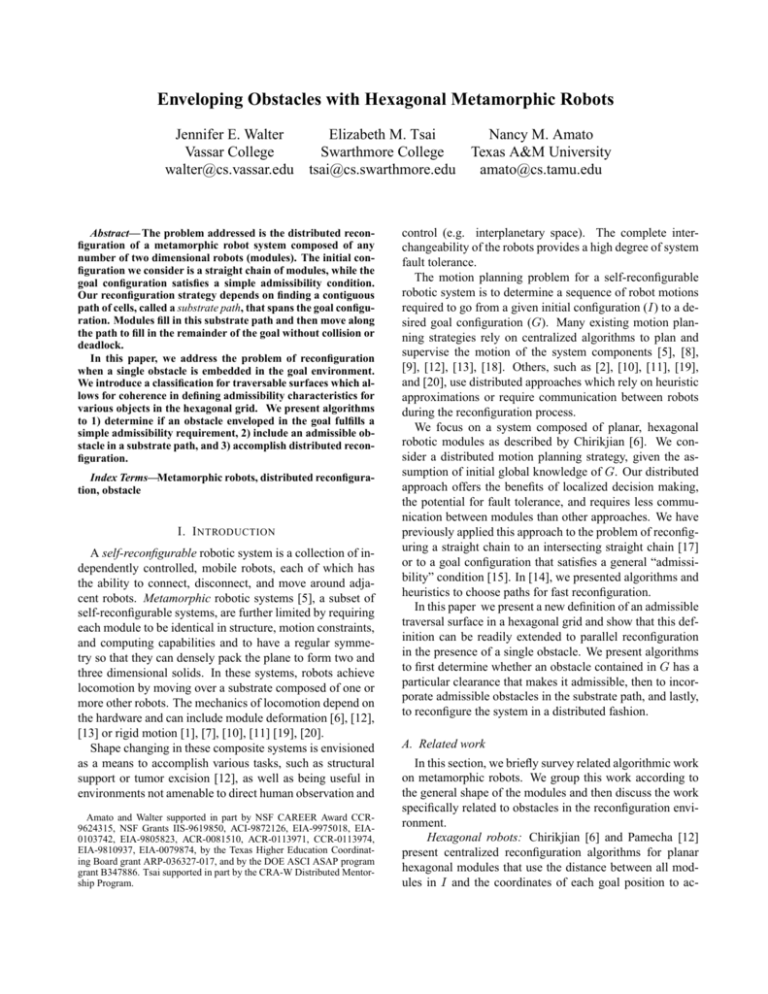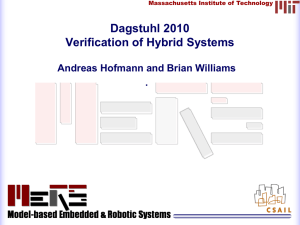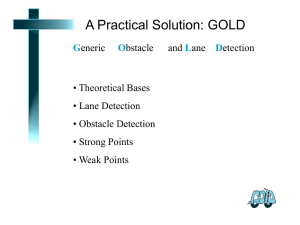ICRA 2003 Paper - pdf format
advertisement

Enveloping Obstacles with Hexagonal Metamorphic Robots
Jennifer E. Walter
Elizabeth M. Tsai
Vassar College
Swarthmore College
walter@cs.vassar.edu tsai@cs.swarthmore.edu
Abstract— The problem addressed is the distributed reconfiguration of a metamorphic robot system composed of any
number of two dimensional robots (modules). The initial configuration we consider is a straight chain of modules, while the
goal configuration satisfies a simple admissibility condition.
Our reconfiguration strategy depends on finding a contiguous
path of cells, called a substrate path, that spans the goal configuration. Modules fill in this substrate path and then move along
the path to fill in the remainder of the goal without collision or
deadlock.
In this paper, we address the problem of reconfiguration
when a single obstacle is embedded in the goal environment.
We introduce a classification for traversable surfaces which allows for coherence in defining admissibility characteristics for
various objects in the hexagonal grid. We present algorithms
to 1) determine if an obstacle enveloped in the goal fulfills a
simple admissibility requirement, 2) include an admissible obstacle in a substrate path, and 3) accomplish distributed reconfiguration.
Index Terms—Metamorphic robots, distributed reconfiguration, obstacle
I. I NTRODUCTION
A self-reconfigurable robotic system is a collection of independently controlled, mobile robots, each of which has
the ability to connect, disconnect, and move around adjacent robots. Metamorphic robotic systems [5], a subset of
self-reconfigurable systems, are further limited by requiring
each module to be identical in structure, motion constraints,
and computing capabilities and to have a regular symmetry so that they can densely pack the plane to form two and
three dimensional solids. In these systems, robots achieve
locomotion by moving over a substrate composed of one or
more other robots. The mechanics of locomotion depend on
the hardware and can include module deformation [6], [12],
[13] or rigid motion [1], [7], [10], [11] [19], [20].
Shape changing in these composite systems is envisioned
as a means to accomplish various tasks, such as structural
support or tumor excision [12], as well as being useful in
environments not amenable to direct human observation and
Amato and Walter supported in part by NSF CAREER Award CCR9624315, NSF Grants IIS-9619850, ACI-9872126, EIA-9975018, EIA0103742, EIA-9805823, ACR-0081510, ACR-0113971, CCR-0113974,
EIA-9810937, EIA-0079874, by the Texas Higher Education Coordinating Board grant ARP-036327-017, and by the DOE ASCI ASAP program
grant B347886. Tsai supported in part by the CRA-W Distributed Mentorship Program.
Nancy M. Amato
Texas A&M University
amato@cs.tamu.edu
control (e.g. interplanetary space). The complete interchangeability of the robots provides a high degree of system
fault tolerance.
The motion planning problem for a self-reconfigurable
robotic system is to determine a sequence of robot motions
required to go from a given initial configuration (I) to a desired goal configuration (G). Many existing motion planning strategies rely on centralized algorithms to plan and
supervise the motion of the system components [5], [8],
[9], [12], [13], [18]. Others, such as [2], [10], [11], [19],
and [20], use distributed approaches which rely on heuristic
approximations or require communication between robots
during the reconfiguration process.
We focus on a system composed of planar, hexagonal
robotic modules as described by Chirikjian [6]. We consider a distributed motion planning strategy, given the assumption of initial global knowledge of G. Our distributed
approach offers the benefits of localized decision making,
the potential for fault tolerance, and requires less communication between modules than other approaches. We have
previously applied this approach to the problem of reconfiguring a straight chain to an intersecting straight chain [17]
or to a goal configuration that satisfies a general “admissibility” condition [15]. In [14], we presented algorithms and
heuristics to choose paths for fast reconfiguration.
In this paper we present a new definition of an admissible
traversal surface in a hexagonal grid and show that this definition can be readily extended to parallel reconfiguration
in the presence of a single obstacle. We present algorithms
to first determine whether an obstacle contained in G has a
particular clearance that makes it admissible, then to incorporate admissible obstacles in the substrate path, and lastly,
to reconfigure the system in a distributed fashion.
A. Related work
In this section, we briefly survey related algorithmic work
on metamorphic robots. We group this work according to
the general shape of the modules and then discuss the work
specifically related to obstacles in the reconfiguration environment.
Hexagonal robots: Chirikjian [6] and Pamecha [12]
present centralized reconfiguration algorithms for planar
hexagonal modules that use the distance between all modules in I and the coordinates of each goal position to ac-
2
complish the reconfiguration of the system. Pamecha et al.
[12] define the distance between configurations as a metric and apply this metric to system self-reconfiguration using a simulated annealing technique to drive the process
towards completion. Murata et al. [10] use a probabilistic
distributed approach to reconfigure a system of hexagonal
modules when position of the goal is irrelevant and only final shape matters.
Square robots: Chiang and Chirikjian [4] present bisecting techniques used to find intermediate configurations
between any given initial and final configurations. They
combine these techniques with the simulated annealing algorithm of Pamecha et al. [12] to reconfigure the system.
Cubic robots: A centralized motion planning strategy
for three dimensional cubic robots is presented by Rus and
Vona [13]. A set of distributed motion planning algorithms
for a system of cubic robots is presented by Butler et al.
in [2]. These algorithms allow modules to move asynchronously after a planning phase that requires extensive
inter-module communication. Murata et al. [11] present a
probabilistic distributed approach to reconfigure a system
of cubic modules.
Rhombic dodecahedral robots: Yim et al. [19], Zhang
et al. [20] and Bojinov et al. [1] present distributed algorithms to reconfigure rhombic dodecahedral modules.
These algorithms are probabilistic and require substantial
message passing between neighboring modules.
Obstacle-related reconfiguration: The presence of obstacles in the reconfiguration environment is briefly considered by Chirikjian in [5]. In this approach, a heuristic is
used to attract modules to an obstacle so that they converge
around it. Bojinov et al. [1] provide a distributed strategy for
grasping objects in the environment using rhombic dodecahedral modules by probabilistically “growing” extensions
to envelop the obstacle. Butler et al. [3] present a rule set
for distributed locomotion of layers of cubic modules over
obstacles on the traversal surface.
B. Our approach and problem definition
Our objective is to design a distributed algorithm that will
cause the modules to move from an initial configuration, I,
in the plane to a known goal configuration, G. This algorithm should ensure that modules do not collide with each
other, and the reconfiguration should be accomplished in a
minimal number of rounds.
The major differences between our approach and those of
other researchers are summarized below:
1) Our algorithms require no message passing.
2) Our algorithms are deterministic, ensuring that the
reconfiguration can be accomplished without deadlock or collision provided I is a straight chain and G
fulfills simple admissibility requirements.
3) Our algorithms are particular to the motion constraints of planar, hexagonal modules.
In Section II we describe the system assumptions and the
problem definition. Section III describes our algorithm for
determining admissibility of a traversal surface. Section IV
introduces simple admissibility conditions for obstacles and
presents a method for reconfiguration in the presence of obstacles. Section VI provides a discussion of our results and
future work.
II. S YSTEM MODEL
The plane is partitioned into equal-sized hexagonal cells
and labeled using the same coordinate system as described
by Chirikjian [5].
A. Assumptions About the Modules
Our model provides an abstraction of the hardware features and the interface between the hardware and the application layer.
- Each module is identical in computing capability and
runs the same program.
- Each module is a hexagon of the same size as the cells of
the plane and always occupies exactly one of the cells.
- Each module knows at all times:
• its location (the coordinates of the cell that it currently
occupies),
• its orientation (which edge is facing in which direction), and
• which of its neighboring cells is occupied by another
module.
Modules move according to the following rules.
1) Modules move in lockstep rounds.
2) In a round, a module M is capable of moving to an
adjacent cell, C1 , iff (see Fig. 1 for an example)
(a) cell C1 is currently empty,
(b) module M has a neighbor S that does not move
in the round (called the substrate) and S is also
adjacent to cell C1 , and
(c) the neighboring cell to M on the other side of C1
from S, C2 , is empty.
3) Only one module tries to move into a particular cell
in each round.
4) Modules cannot carry, push, or pull other modules,
i.e., a module is only allowed to move itself.
If the algorithm does not ensure that each moving module
has an immobile substrate, as specified in rule 2(b), then
the results of the round are unpredictable. Likewise, the
results of the round are unpredictable if the algorithm does
not ensure rule 3.
III. A DMISSIBLE TRAVERSAL SURFACES
In this section we present a classification of traversable
surfaces in a hexagonal system under the motion constraints
presented in Section II.
3
Before module M moves
4
C2
C2
6
5
After module M moves
1
M
3
C3
2
4
3
C1
2
S
S
M
5
6
1
Unoccupied cell
Occupied cell
(Numbers in cell M indicate initial and final orientation)
Fig. 1. Before and after module movement. S is substrate module.
In the following definition, let set T represent a particular
set of cells in the plane.
Definition 1: The d-clearance of a cell i ∈ T is the number of consecutive cells 6∈ T that are aligned along the outgoing vector originating in the center of cell i and normal to
side d, d ∈ {N, S, NW, SW, NE, SE}.
Figure 2 shows a cell with a SE-clearance ≥ 3.
Cell in T
SE side
Cell not in T
c1
c2
c3
Fig. 2. Cell with SE-clearance ≥ 3.
Let s be a contiguous sequence of distinct cells,
c1 , c2 , . . . , ck from a set T such that each cell is adjacent
to the previous. The adjacency direction between two contiguous cells ci and ci+1 is the side of ci that is adjacent to
ci+1 .
Definition 2: A segment of s is a contiguous subsequence
of s of length ≥ 2. In a d-segment, each cell is direction d
of the previous.
Definition 3: A cell ci ∈ s is the end (resp. beginning)
of a d-segment if cell ci+1 (resp. ci ) is adjacent to ci (resp.
ci−1 ) in some direction not equal to d.
The admissibility conditions for a traversal surface are directly related to the degree of parallelism possible, i.e., how
closely modules moving across the surface can be spaced. If
moving modules are separated by only a single empty cell,
they will become deadlocked in acute angle corners when
running our algorithms [17]. However, acute angle intersections are very commonplace in configurations of hexagonal
robots. Our definition of an admissible traversal surface is
therefore based on configuration surfaces over which moving modules with two empty cells between them can move
without collision or deadlock.
We present our definition of an admissible traversal surface for the situation where modules traverse the surface
from west to east, and then make a similar definition for
the situation where traversal is from east to west.
Definition 4: An east-monotone admissible traversal
surface is a contiguous sequence s = c1 , c2 , . . . , ck of distinct cells from a set T such that
1) no ci is the end of a NW or SW segment (i.e., each
cell is adjacent to the previous, but not to its west),
2) the north side of s is such that
a) every ci in a N segment with NW-clearance > 0
has NW-clearance ≥ 3, and
b) every ci in a S segment with NE-clearance > 0
has NE-clearance ≥ 3; and
3) the south side of s is such that
a) every ci in a S segment with SW-clearance > 0
has SW-clearance ≥ 3, and
b) every ci in a N segment with SE-clearance > 0
has SE-clearance ≥ 3.
Figure 3 shows examples of surfaces (depicted by shaded
cells) that are composed of a sequence of distinct, contiguous cells, with cells on the north side shaded. The cells
in each of these surfaces can be numbered consecutively,
from west to east, so that they adhere to Definition 4, part 1.
Figure 3, parts (a) and (d) show the north and south sides,
respectively, of an east-monotone admissible traversal surface. Parts (b) and (c) show north sides of surfaces that violate parts 2a and 2b of Definition 4, respectively. Parts (e)
and (f) show south sides of surfaces that violate Definition
4 parts 3a and 3b, respectively.
(a)
(b)
(d)
(e)
(c)
(f)
Fig. 3. East-monotone admissible surface (a). In (b), (c), (e), and (f), the
black cells violate Definition 4, parts 2a, 2b, 3a and 3b, respectively.
A west-monotone admissible traversal surface is defined
exactly as the east-monotone admissible surface except that
in Definition 4, part 2, NW is substituted for NE and vice
versa, and SE is substituted for SW and vice versa in Definition 4, part 3.
A. Admissible goal configurations
In this section we define admissible goal configurations
and describe a centralized algorithm that tests whether a
given configuration is admissible, i.e., whether it contains
4
an admissible substrate path. Note that we do not consider
goal configurations that contain obstacles in this section, as
the admissibility of the goal is determined independent of
obstacle admissibility. The presence of obstacles in the goal
environment, as well as conditions for obstacle admissibility, are discussed in Section IV.
Without loss of generality, assume I is a straight chain
that intersects G in exactly one cell on the perimeter of G.
The number of modules in I and the number of cells in G is
n.
Let G1 , G2 , . . . , Gm be the columns of G, such that G1
is the column in which I intersects G and Gm is the column
furthest from column G1 . Suppose that G is oriented such
that column G1 is the westmost column, Gm is the eastmost
column, and each column of G is a contiguous straight chain
oriented north-south. Figure 4 shows how the columns of G
are labeled.
The assumptions concerning the relative positions of I
and G can be made without loss of generality because if I
is a straight chain that is not intersecting G, then the algorithms presented in [17] for straight chain to straight chain
reconfiguration can be used to reorient I in relation to G. I
is assumed to be a straight chain only because this configuration is well-defined. We intend to relax this assumption in
future work.
Definition 5: Let a path p be a contiguous sequence of
distinct cells, c1 , c2 , . . . , ck .
In the remainder of this paper, north and south segments
of p may be referred to as vertical segments when it is not
necessary to be more specific about direction.
Definition 6: p is an admissible substrate path if
p begins with the cell in which I and G overlap,
subsequent cells are all in G,
p spans G, from column G1 to column Gm ,
each ci in p forms the beginning of a vertical segment
only if there is no goal cell to the NE or SE of ci−1 , and
5. both the north and south sides of p form an eastmonotone admissible traversal surface with respect to set
T , the set of all cells in G.
1.
2.
3.
4.
Definition 7: G is an admissible goal configuration if
there exists an admissible substrate path in G.
Figure 4 depicts an example of an admissible (a) and an
inadmissible (b) configuration of G.
B. Finding substrate paths
Our procedure for finding an admissible substrate path in
G was presented in [14] and [15]. In this paper, we only
briefly review this procedure.
• Label the columns of G as described in the beginning
of this section, with the cells in each Gi labeled Gi,1 ,
Gi,2 ,. . ., from north to south.
G
1
G
G
2
G
4
3
G
5
G
6
G
1
G
2
G
3
(a)
G
4
G
5
G
6
G
7
(b)
Occupied non−goal cell
Substrate path
Unoccupied goal cell
Occupied goal cell
Fig. 4. Example admissible (a) and inadmissible (b) G.
G1
G1
N
N
N
C
C
C
C
C
Gm
Gm
C
C
C
C
C
C
C
C
C
C
C
C
C
C
S
(a)
N
C
S
S
Node in north segment
Node in central segment
Node in south segment
(b)
Marked goal cell
Edge direction
Fig. 5. Directed graph H formed by algorithm.
• Represent each goal cell as a node in a graph H. Initially
there is an undirected edge between each pair of adjacent
goal cells.
Once H has been initialized, the edges are directed by
marking the vertices that are determined to have an admissible path to a goal cell in the eastmost column. This is
accomplished by the D IRECT E DGES algorithm as follows:
• First, every node in column Gm is marked, as shown
in Figure 5(a). Each column west of column Gm (i.e.,
columns G1 through Gm−1 ) is divided into three segments
(labelled in Figure 5(a)): (N) the north segment of the column with no goal cells to the east (possibly empty), (C)
the central segment of the column, consisting of cells that
have goal cells to the east, and (S) the south segment of the
column with no goal cells to the east (possibly empty).
• For each column, Gm−1 down to G1
1. Nodes in segment (C) are processed north to south. If
a node in segment (C) has one or more marked neighbors to the east, it is marked and given a directed edge
to each marked neighbor. The only exceptions are when
a NE (resp. SE) edge would be directed toward a neighbor with an outgoing S (resp. N) edge (eg., Figure 5(b),
where goal cell G4,4 is marked, but its SE edge is not
5
directed). These exceptions ensure that no acute angle
corners will be included in any substrate path.
2. Nodes in segment (S) are processed north to south. Each
node is marked and given a directed edge to its north
neighbor if the north neighbor is marked and if the edge
is a prefix of some admissible path.
3. Nodes in segment (N) are processed south to north. Each
node is marked and given a directed edge to its south
neighbor if the south neighbor is marked and if the edge
is a prefix of some admissible path.
Once H has been constructed (as shown in Figure 5(b)), a
graph traversal algorithm is used to find all admissible substrate paths from column G1 to column Gm in the graph.
A weighting heuristic that favors straight and single-bend
paths (i.e., those that allow for maximum parallel movement
of modules) is used in conjuction with the graph traversal to
rank the candidate paths. The substrate path used for reconfiguration is then selected from this ranked set by using
a second heuristic that gives preference to paths that most
evenly bisect the goal configuration. During reconfiguration, modules fill the substrate path first, then move along
both sides of the path to fill in the rest of G in columns from
E to W and from the path outward to the N and S.
IV. O BSTACLES
In this section, we consider the presence of a single obstacle in the coordinate system and present a strategy for
reconfiguration when obstacles are present in the goal.
An obstacle is a sequence of one or more “forbidden
cells” that modules cannot enter. We consider obstacles that
are composed of hexagons of the same size as the cells of
the plane and we assume each hexagon in the obstacle occupies exactly one of the cells. Since at this point, we consider
only the presence of obstacles that are contained completely
within G, the cells surrounding the obstacle are goal cells.
Modules may touch obstacle perimeter cells and may use
them as substrate for movement.
Definition 8: An obstacle is admissible if
1) it is completely enclosed by the cells of G, and
2) every obstacle cell has infinite d-clearance for each
side d with d-clearance > 0, where the set T is defined as the set of all obstacle cells.
Definition 8 requires obstacle cells on the perimeter of an
admissible obstacle to have an infinite d-clearance with respect to other obstacle cells. Here, the set T from Definition
1 includes only the obstacle cells because we want to ensure
that the obstacle surface contains no holes or pockets where
modules may become trapped. We are currently working
on algorithms to determine the proper order in which to fill
cells in holes on an obstacle surface but that is a subject for
future work.
A. Reconfiguration with admissible obstacles inside G
Even if an obstacle contained in G is admissible, our reconfiguration algorithms must ensure that narrow “pockets”
do not form on the the obstacle perimeter during reconfiguration.
(a)
(b)
Obstacle cell
Goal cell on substrate path
Goal cell
Blocked goal cell
Fig. 6. Filling in G using substrate path that does not pass through obstacle. Part (a) shows an admissible obstacle, a possible substrate path in
G and the goal cells that could not be filled in due to lack of clearance for
module movement. Part (b) shows another admissible obstacle, a possible substrate path found through G, and goal cells that would be blocked
during reconfiguration.
Situations where pockets can form during reconfiguration
are shown in Figure 6. In part (a), some cells between the
substrate path and the obstacle are blocked after the substrate path is filled. This problem is easily solved by requiring the substrate path to pass through the obstacle, thereby
forming a combination obstacle and substrate path traversal
surface. Figure 6(b) shows a possible substrate path chosen by the algorithms presented in Section III. This path
passes through the obstacle, and forms a traversable path to
the west of the obstacle. Because the substrate path is filled
first and then the remaining goal cells are filled in columns
from east to west and from the substrate path outward, the
goal cells marked with “X”s in Figure 6(b) will not be filled
due to motion constraints on the modules.
To avoid this problem, we want the obstacle to “taper”
from west to east, so that the eastmost column contains a
single cell. Figure 7(a) shows an obstacle that has been
augmented with “repaired” goal cells which will be filled
in, from west to east, before the rest of the goal to the east
of the obstacle is filled. Part (b) of Figure 7 shows a possible
admissible substrate path adjoined to the repaired obstacle.
The algorithm to repair obstacles prior to reconfiguration is
presented in the following section.
B. Algorithm to repair obstacles
Obstacles are repaired in a single pass, from west to east,
by identifying goal cells in the “cone” to the east of the obstacle and adding them to a set of “repaired” cells.
Let G be oriented as described in Section III and let t be
the number of columns in the obstacle. Let R1 , R2 , . . . , Rt
be the columns of the obstacle, labeled from west to east.
6
Obstacle cell
Repaired goal cell
Goal cell on substrate path
Goal cell
Fig. 7. Repaired obstacle in G (a). Part (b) shows the repaired obstacle
and a possible substrate path found in this configuration.
Initially, the only repaired cells are the obstacle cells themselves. For each column Ri (1 ≤ i ≤ t), number the
obstacle cells from north to south, starting with 1 for the
northmost cell in each column. The algorithm converts
the surface of the obstacle to an east-monotone admissible
traversal surface by adding repaired cells if possible. The
algorithm checks existing repaired cells with NE- or SEclearance > 0 for NE- or SE-clearance ≥ 3 with respect
to T , the set of all goal and obstacle cells. The set T includes both goal and obstacle cells in this case because we
must consider the clearance that modules moving over the
repaired obstacle will have when goal cells to the east are
filled. Obstacle repair is accomplished as follows:
For each column R1 to the eastmost column containing repaired cells, examine each cell, Ri,j , in the column from
north to south.
− If Ri,j has an obstacle or repaired cell to the N: if there is
a goal cell to the NE, mark the NE cell as repaired; else if
there is not a goal cell to the NE and Ri,j does not have
NE-clearance ≥ 3, the obstacle is unrepairable.
− If Ri,j has an obstacle or repaired cell to the S: if there is
a goal cell to the SE, mark the SE cell as repaired; else if
there is not a goal cell to the SE and Ri,j does not have
SE-clearance ≥ 3, the obstacle is unrepairable.
Continue to repair the obstacle until the “cone” shape is
achieved (i.e., until all obstacle columns have been processed and either Ri,1 has no more repaired cells to the N
or S or all cells in the eastmost column of R have NE- and
SE-clearance ≥ 3) or until the obstacle is found to be unrepairable.
Figure 8 shows snapshots taken during the execution of
the repair of an obstacle, with time progressing from (a) to
(c).
Figure 9(a) shows a goal configuration containing an admissible obstacle that is not repairable. In Figure 9(b), cell
R3,1 has a repaired cell to the S, but the cell to the SE of cell
R3,1 is not a goal cell and R3,1 does not have SE-clearance
≥ 3 with respect to the set of all goal cells (T ).
(c)
(b)
(a)
(b)
(a)
Repaired goal cell
Obstacle cell
Goal cell
Fig. 8. Example obstacle repair. In part (a), cells R2,1 and R2,3 are
repaired when R1,1 and R1,4 are processed. In part (b), cells R3,1 and
R3,2 are repaired when R2,1 and R2,3 are processed. In part (c), cell R4,1
is repaired when cell R3,1 is processed.
(a)
Obstacle cell
(b)
Repaired goal cell
Goal cell
Fig. 9. Obstacle in G (a) and unrepairable obstacle (b).
V. D ISTRIBUTED RECONFIGURATION ALGORITHM
In this section, we describe the distributed algorithm that
performs the reconfiguration of I to G after the goal and the
obstacle are determined to be admissible and the obstacle
surface is repaired.
The overall reconfiguration proceeds as outlined in Figure 10.
if obstacle contained in G is admissible and repairable
1. find asp from G1 to westmost column of obstacle.
2. find asp from eastmost cell of repaired obstacle to Gm .
3. fill in cells of G in the following order:
a) asp west of obstacle, west to east,
b) repaired cells north and south of obstacle, west to east,
c) repaired cells east of obstacle, west to east,
d) asp east of obstacle (if it exists), and
e) north and south of asp/obstacle, from east to west.
else report failure.
Fig. 10. Schema for reconfiguration with obstacles (asp is an abbreviation
for admissible substrate path).
In step 1 of the reconfiguration schema in Figure 10,
algorithm D IRECT E DGES is run, beginning by marking
the cells in the westmost column of the obstacle instead
of the cells in Gm . This ensures that the substrate path
will abut against the westmost column of the obstacle.
The western substrate path is then selected using the algorithms described in Section III. Step 2 uses algorithm D I RECT E DGES to direct the edges from the cell in the eastmost column of the repaired obstacle to column Gm . This
step is unnecessary if the repaired cells extend into column
Gm .
A. Algorithm assumptions
1. Each module knows the total number of modules in the
system, n, and the goal configuration, G.
7
2. Initially, one module is in each cell of I.
3. G is an admissible goal configuration (note that obstacle
cells are treated as goal cells in check for goal admissibility.)
4. The obstacle contained in G is a repaired admissible obstacle.
5. I and G overlap in one goal cell in column G1 , as described in Sect. III.
B. Overview of algorithm
The algorithm works in synchronous rounds.
In
each round, each module determines whether it is free
(cf. Fig. 11). In this figure, the modules labeled trapped
are unable to move due to hardware constraints and those
labeled free represent modules that are allowed to move in
our algorithm, possibly after some initial delay. The modules in the other category are restricted from moving by our
algorithm, not by hardware constraints.
Coordinates of goal cells to the north and south of the
substrate path are also stored in arrays at each module. A
module calculates the goal cell it will occupy using its position in I, the length of the arrays of coordinates on, north,
and south of the cells in f , and the current count of modules
that have passed on both sides.
Modules fill in f first, with module 1 filling the first cell
in ordered array f , module 2 filling the second cell, and so
on. After every goal cell in f is filled, modules alternate
rotation directions, filling the columns projecting north and
south of f from east, Gm , to west, G1 .
Figure 12 shows snapshots of the execution of the distributed algorithm. Initially, only module 24 in the straight
chain I intersects G and I is slanted from NW to SE. Figure 12(a) is a snapshot of the execution taken after round
4, when modules 1 and 2 have started moving. Parts (b)
through (f) are snapshots after rounds 25, 33, 38, 42, and
65, respectively.
2
3
TRAPPED
4
1
FREE
22 23
24
3
2
22 23
24
1
OTHER
Indicates non−contact edge
Indicates contact edge
Fig. 11. Contact patterns possible in algorithm.
All modules except module 1 dynamically calculate their
position in I, direction of rotation, possible delay and final
coordinates in G by counting the modules in initial positions
further from the intersection of I and G as they pass and
noting the direction (CW or CCW) in which the passing
modules rotate.
Let f be the array of coordinates of goal cells (stored
locally at each module) starting with the cell that has an
edge incoming from the cell in which I and G intersect in
column G1 . The cells are inserted in f in the following
order:
1. cells in the substrate path west of the obstacle, from west
to east,
2. repaired cells north of the obstacle, in columns from west
to east and ordered within the columns from south to
north,
3. repaired cells south of the obstacle, in columns from west
to east and ordered within the columns from north to
south,
4. repaired cells east of the obstacle, in columns from west
to east and ordered within the columns from south to
north, and
5. cells on the substrate path east of the obstacle (if they
exist), from west to east.
(a)
6
22 5
23
24
1
(b)
6
4
2
22
%% &
%% 7&
%% &%%
23&
&
&
## &
## &&% $
## $
## $##
% 24
% $
% $
&
&
&
8
$
# $
# $
# 1$
# $$#
$
$
$
$
2
3
3
9
23
24
1
10 7
2
5 3
4
6
19
21
15
17
24
1
22
23
8
(e)
"!"! "!"! "!"! "!"!
"!"! "! "!
4
(d)
(c)
22
5
11 9
7
5 6
8
4
10
3
12
14
2
18
20
16
Obstacle cell
13
(f)
Repaired goal cell
Goal cell on substrate path
Goal cell (not repaired and
not on substrate path)
Numbers and shading indicate current module locations.
Fig. 12. Snapshots of execution of distributed algorithm.
Modules use the rotation patterns listed below.
1. unidirectional: Module i rotates in the same direction as
module i − 1.
2. bidirectional: Module i rotates in the opposite direction
as module i − 1.
8
Each module maintains a variable delay, the number of
time units a module waits after it is free (cf. Figure 11)
and before it makes its first move. Initially, delay = 0. The
choice of module rotation and and value of delay depends
on its position in I:
• For modules 1 through |f | (i.e., those modules filling in
the substrate path and repaired cells):
– Module 1 has delay = 0; modules 2 . . . |f | have unidirectional rotation and delay = 2 unless otherwise noted.
– If module position corresponds to a position in f on the
west substrate path,
• if the west substrate path meets the obstacle at a NW
to SE slant, rotation = CCW.
• else if the west substrate path meets the obstacle at a
SW to NE slant, rotation = CW.
– For the lowest module position i corresponding to . . .
. . . a cell in f north of obstacle, start CW. If module i − 1
went CCW, delay = 1.
. . . a cell in f south of obstacle, start CCW. If module i − 1
went CW, delay = 1.
. . . a cell in f east of obstacle, start CW. If module i − 1
went CCW, delay = 1.
. . . a cell in f on the east substrate path, start CW. If module i − 1 went CCW, delay = 1.
• For modules in positions |f | + 1 . . . n − 1: modules use
bidirectional rotation with delay = 1 for modules rotating
CW and delay = 0 for those rotating CCW until all cells
either north or south of f are filled. After this, modules use
unidirectional pattern, with either CW or CCW direction
and delay = 2.
• The module in position n does not move.
• Once a module stops for a round in the goal cell it has
calculated it should occupy, it never moves out of that goal
cell.
The pseudocode for the distibuted reconfiguration is the
same as that used when no obstacles occur in the goal environment. Since this pseudocode was presented in detail in
[14], we only briefly review it here.
In each round, every module that is not already in its calculated final goal cell checks its contact pattern (cf. Figure
11), i.e., on which sides it contacts other modules. In the
first round a module detects that it has a free contact pattern, it calculates the value of delay according to its position, as described above. If delay = 0, the module moves,
also choosing its rotation direction according to its position
as described earlier; otherwise, if delay > 0, the module
decrements delay and does not move in that round. After a
module begins moving, it moves in every round until it occupies the goal cell that it has calculated as its final position.
VI. C ONCLUSIONS AND FUTURE WORK
We have presented a classification of admissible traversal
surfaces in the hexagonal grid which allows for generality
and coherence when defining admissibility conditions for
various objects in the environment. We also addressed the
problem of reconfiguration in the presence of a single obstacle enveloped by the goal, using the definition of admissible
traversal surfaces to repair the surface of the obstacle prior
to distributed reconfiguration.
In this paper, the obstacle admissibility requirements
were very simple. In our current work, we are extending the definition of admissible surfaces to include embedded obstacles with more complex surfaces. We believe that
the ability to repair an obstacle surface will also be helpful
in designing reconfiguration algorithms for goal configurations containing multiple obstacles.
R EFERENCES
[1] H. Bojinov, A. Casal, and T. Hoag. Emergent structures in modulular selfreconfigurable robots. In Proc. of IEEE Intl. Conf. on Robotics and Automation,
Vol. 2, pages 1734–1741, 2000.
[2] Z. Butler, S. Byrnes, and D. Rus. Distributed motion planning for modular
robots with unit-compressible modules. In Proc. of IEEE Intl. Conf. on Intelligent Robots and Systems, pages 790–796, 2001.
[3] Z. Butler, K. Kotay, D. Rus, and K. Tomita. Generic decentralized control for
a class of self-reconfigurable robots. In Proc. of IEEE Intl. Conf. on Robotics
and Automation, pages 809–816, May 2002.
[4] C.-J. Chiang and G. Chirikjian. Similarity metrics with applications to modular
robot motion planning. Autonomous Robots Journal, Special Issue on SelfReconfiguring Robots, Vol. 10, No. 1, pages 91–106, Jan. 2001.
[5] G. Chirikjian. Kinematics of a metamorphic robotic system. In Proc. of IEEE
Intl. Conf. on Robotics and Automation, pages 449–455, 1994.
[6] G. Chirikjian, A. Pamecha, and I. Ebert-Uphoff. Evaluating efficiency of selfreconfiguration in a class of modular robots. Journal of Robotic Systems,
Vol. 13, No. 5, pages 317–338, May 1996.
[7] K. Hosokawa, T. Tsujimori, T. Fujii, H. Kaetsu, H. Asama, Y. Kuroda, and
I. Endo. Self-organizing collective robots with morphogenesis in a vertical
plane. In IEEE Intl. Conf. on Robotics and Automation, pages 2858–2863,
May 1998.
[8] K. Kotay and D. Rus. Motion synthesis for the self-reconfiguring molecule. In
IEEE Intl. Conf. on Robotics and Automation, pages 843–851, 1998.
[9] K. Kotay, D. Rus, M. Vona, and C. McGray. The self-reconfiguring robotic
molecule: design and control algorithms. In Workshop on Algorithmic Foundations of Robotics, pages 376–386, 1998.
[10] S. Murata, H. Kurokawa, and S. Kokaji. Self-assembling machine. In Proc. of
IEEE Intl. Conf. on Robotics and Automation, pages 441–448, 1994.
[11] S. Murata, H. Kurokawa, E. Yoshida, K. Tomita, and S. Kokaji. A 3-D selfreconfigurable structure. In Proc. of IEEE Intl. Conf. on Robotics and Automation, pages 432–439, 1998.
[12] A. Pamecha, I. Ebert-Uphoff, and G. Chirikjian. Useful metrics for modular robot motion planning. IEEE Transactions on Robotics and Automation,
13(4):531–545, 1997.
[13] D. Rus and M. Vona. Crystalline robots: Self-reconfiguration with compressible unit modules. Autonomous Robots Journal, Special Issue on SelfReconfigurable Robots, Vol. 10, No. 1,pages 107–124, Jan. 2001.
[14] J. Walter, B. Tsai, and N. Amato. Choosing good paths for fast distributed
reconfiguration of hexagonal metamorphic robots. In Proc. of the IEEE Intl.
Conf. on Robotics and Automation, pages 102-109, May 2002.
[15] J. Walter, J. Welch, and N. Amato. Concurrent metamorphosis of hexagonal
robot chains into simple connected configurations. Accepted to IEEE Transactions on Robotics and Automation, 2002.
[16] J. Walter, B. Tsai, and N. Amato. Concurrent reconfiguration of hexagonal
metamorphic robots: Algorithms for fast execution and obstacle envelopment.
Submitted, 2002.
[17] J. Walter, J. Welch, and N. Amato. Distributed reconfiguration of metamorphic
robot chains. In Proc. of ACM Symp. on Principles of Distributed Computing,
pages 171–180, 2000.
[18] M. Yim. A reconfigurable modular robot with many modes of locomotion. In
Proc. of Intl. Conf. on Advanced Mechatronics, pages 283–288, 1993.
[19] M. Yim, J. Lamping, E. Mao, and J. G. Chase. Rhombic dodecahedron shape
for self-assembling robots. SPL TechReport P9710777, Xerox PARC, 1997.
[20] Y. Zhang, M. Yim, J. Lamping, and E. Mao. Distributed control for 3D
shape metamorphosis. Autonomous Robots Journal, Special Issue on SelfReconfigurable Robots, 2000.







